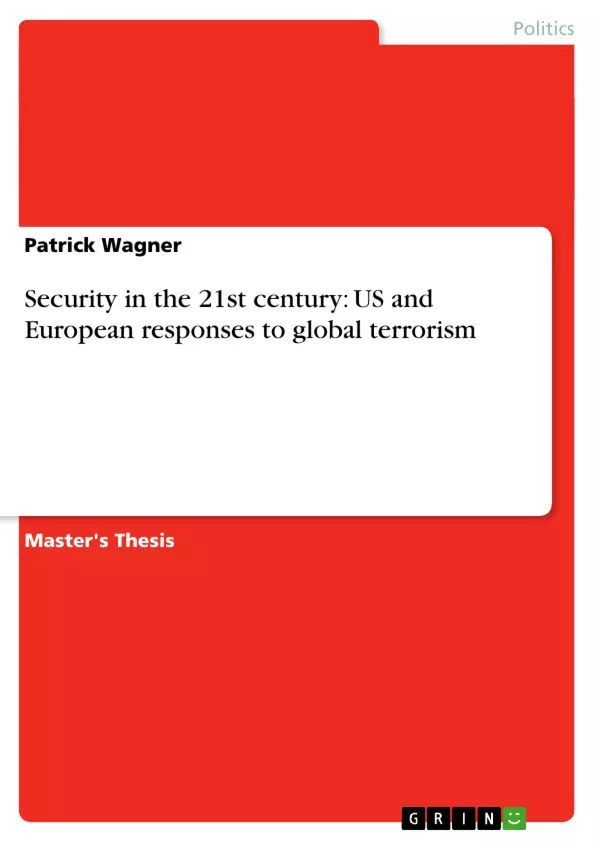Although the world stood united behind America when the dust of the collapsed twin towers of the World Trade Centre settled, differences between the United States and Europe soon became apparent. Europe might have supported the US in Afghanistan, both politically and militarily, but diverging interests already became apparent when the US sidelined NATO and preferred to lead ‘Operation Enduring Freedom’ itself. The dispute escalated over the US plans to continue the war on terror in Iraq. Here, it emerged that the US and Europe do not share the same world view. While the US seem to perceive the world in Hobbesian terms, and believe that military strength is the only means to achieve security, Europe appears to understand security in the Kantian sense and believes that ‘perpetual peace’ can be achieved. The question that divided Europe and the US over Iraq then is more than a simple difference of opinion but reflects a deep philosophical division: Can global security be achieved by force or through sustained dedication to a set of normative principles implemented by the world community? Consequently, the counterterrorism strategies formulated in Europe and the US are of a fundamentally different nature, which cannot be explained merely by the discrepancy in military capabilities. If that would be the case, Europe would have begun to build up its military potential by now.
Acknowledging that “terrorism has become one of the most pressing political problems,” (David Whittaker) the aim of this paper is to compare the US and the European approach to global terrorism, establish reasons for the differences and evaluate which approach might be more effective.
As September 11, has changed our perception of security by demonstrating that even the US is, despite its unrivalled military superiority, vulnerable to attack, carried out by just 19 men armed with cardboard cutters, we should remain aware that the responses we chose to these attacks reflect our dedication to human rights, the rule of law and indeed freedom. Relying on military strength is easier than to acknowledge that terrorism is caused by a fundamentally unjust economical and political world order that markedly favours the West, yet it might ultimately prove to become more dangerous than terrorism itself, as it does nothing to resolve the problem but reinforces the world order that is the cause of the problem.
Inhaltsverzeichnis (Table of Contents)
- Preface
- Introduction
- Risks and Strategies in the Post-Cold War Era
- Post-Cold War Security
- The 'War Fighting' Approach
- The 'Crime Fighting' Approach
- The US Response - An Outward Oriented Approach?
- The National Security Strategy of the United States
- Donald Rumsfeld's Defence Vision
- Homeland Security
- The European Response - An Inward Oriented Approach?
- Justice and Home Affairs
- Exporting the European Experience
- Diplomacy and Development
- War Fighting or Crime Fighting or Another Way?
- Reasons for the Differences
- Effectiveness
- Alternatives
- Conclusion
Zielsetzung und Themenschwerpunkte (Objectives and Key Themes)
This dissertation examines the United States and European responses to global terrorism in the wake of the September 11th attacks. It analyzes the different approaches taken by both sides, specifically focusing on the "War Fighting" and "Crime Fighting" strategies. The dissertation explores the reasons for these divergent strategies and assesses their effectiveness in combating terrorism.
- Post-Cold War Security Dynamics
- US and European Counterterrorism Strategies
- The "War Fighting" and "Crime Fighting" Approaches
- The Transatlantic Relationship and Cooperation
- Effectiveness of Counterterrorism Measures
Zusammenfassung der Kapitel (Chapter Summaries)
The preface provides a brief overview of the dissertation's context and motivation, highlighting the uncertainty surrounding the "war on terror" and the evolving transatlantic relationship. The introduction establishes the context of the post-Cold War era and the emergence of new security threats, including terrorism.
Chapter 1 analyzes the shifting security landscape in the post-Cold War era, exploring the emergence of terrorism as a significant threat and contrasting the "War Fighting" and "Crime Fighting" approaches to counterterrorism.
Chapter 2 examines the US response to global terrorism, focusing on the "National Security Strategy of the United States" and the defense vision of Donald Rumsfeld. It also explores the development of homeland security measures.
Chapter 3 delves into the European response to terrorism, examining the role of the Justice and Home Affairs framework, the "export" of European counterterrorism experiences, and the emphasis on diplomacy and development.
Chapter 4 analyzes the differences between the US and European responses to terrorism, exploring the reasons for these divergences and assessing their effectiveness in combating terrorism. It also considers alternative approaches to counterterrorism.
Schlüsselwörter (Keywords)
The key keywords and focus topics of this dissertation include: counterterrorism, global terrorism, post-Cold War security, War Fighting, Crime Fighting, transatlantic relations, US national security strategy, European security, diplomacy and development, and effectiveness of counterterrorism measures.
- Quote paper
- Patrick Wagner (Author), 2004, Security in the 21st century: US and European responses to global terrorism, Munich, GRIN Verlag, https://www.grin.com/document/29625



